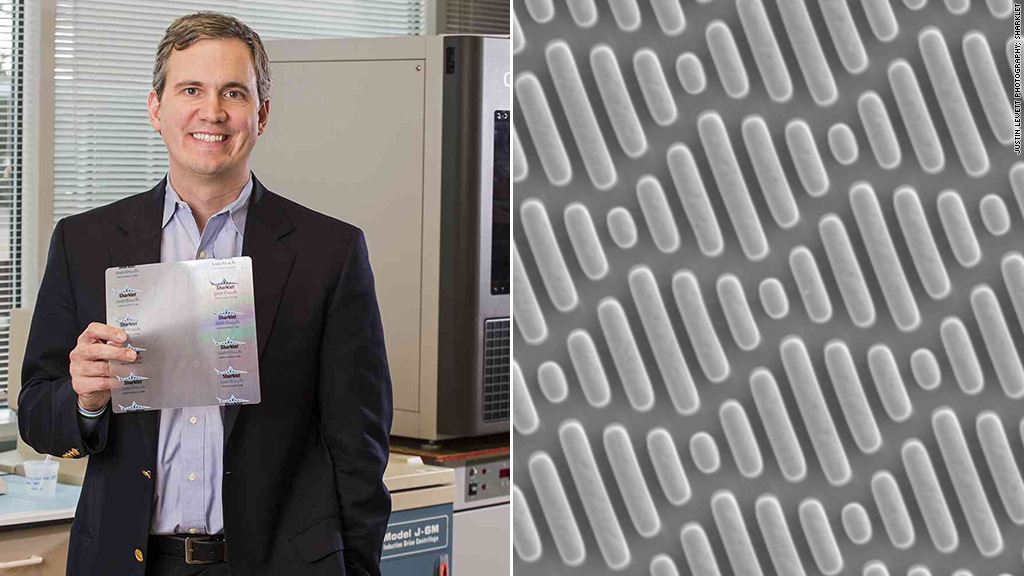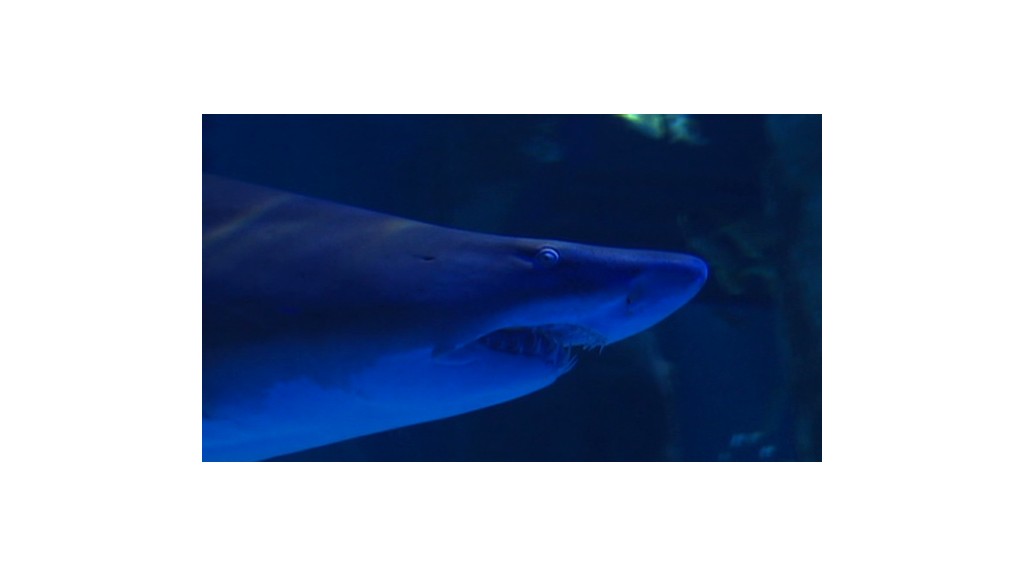
Forget chemicals or pills in the fight against nasty bacterial infections. Entrepreneur Mark Spiecker is betting that the secret lies with sharks.
Those fast and carnivorous fish just happen to have microscopic textures on their skin that make them highly resistant to barnacles, algae and, surprisingly, most human bacteria.
Spiecker is CEO of a six-year-old company called Sharklet Technologies that has copied those mathematical patterns to create germ-deflecting surfaces for everything from medical devices to computer keyboards.
The textures are invisible to the eye -- and to the finger. Measured in microns, the surface ridges are about 1/10th the width of a human hair. Depending on the specific bug, they cut bacteria by 90% to 99.99%, according to Spiecker.
Backed by $5.2 million from investors, the 14-employee firm has attracted nine customers, including office furniture maker Steelcase (SCS) and medical device maker Cook Medical. The company has collected $2.6 million in federal research & development grants, and last year, its sales reached $1 million.
Sharklet's technology sits smack in the middle of a burgeoning field called "biomimicry," which explores how nature can be copied to solve human problems.
Bacterial resistance is an especially hot topic, thanks to growing concerns about the rise of antibiotic-resistant infections. In 1976, only 5% of staph infections were resistant. Today, more than half are, meaning they're tougher to treat and far more deadly. Scientists are studying everything from kangaroos' stomachs to leafcutter ants to glean the natural world's antibacterial secrets.
If the patterns found in sharkskin actually work in the human medical world, the breakthrough could be big, says Steve Brozak, who tracks the medical device industry as president of investment services firm WBB Securities in New Jersey. "Sharklet's technology could be important today and could be absolutely necessary tomorrow," he says.
So how do you go from ancient ocean creatures to a disruptive medical technology? Sharklet's story began in 2000, when the U.S. Navy asked University of Florida materials science professor Anthony Brennan to find a way to reduce the drag on Navy ships from barnacles and algae.
Related story: How whale song inspired an oceanic robot army
At a Hawaiian conference, Brennan and his fellow researchers stood on a pier by the water talking through the problem. Brennan wondered aloud why whales have barnacles on their skin but sharks do not. His colleagues brushed off the question, saying that sharks simply swam too fast.
The answer didn't satisfy Brennan. "My friend looked at me and said, 'I'll catch a shark for you if you want,'" he says. One month later, as promised, he opened a package containing a mold of shark scales taken from the shark his buddy had caught and released.

In laboratory tests, Brennan discovered his theory was right: The sharks' skin repelled 85% of the algae. But it took another five years before Brennan serendipitously discovered that the resistance also worked on human pathogens. A student accidentally tried --and failed -- to grow bacteria on a sharkskin-patterned petri dish.
"It was difficult for us to figure out why it works," Brennan says. "And we still don't completely understand, but we have theories."
University officials wanted Brennan to commercialize his discovery, but he didn't want to be an entrepreneur. Eventually, he called a friend and businessman named Greg Garvis, who came to Florida with a pair of business strategists. The three men were blown away.
"We knew it was important technology as soon as we saw it," says Joe Bagan, one of the advisors.
In October 2007, the four partners started Sharklet Technologies, which was soon financed by $1.2 million from investors. Brennan signed on as chief scientific officer. Bagan became the company's first CEO.
The new startup faced a big problem right away: Getting the patterns to work in the laboratory is one thing, but how do you mass-produce a texture that's 3 millionths of a meter deep?
Sharklet's executives spent two years searching for people who could help them solve that problem. They visited medical device trade shows, talked to semiconductor manufacturers and met endlessly with experts in photolithography, microreplication and laser etching. At times, they doubted the company would survive, says Spiecker, who was the chief operating officer at the time.
"A lot of people said we just couldn't do it," he says. "We were pushing the limits of manufacturing technology."
Finally, Spiecker found a Massachusetts company called FLEXCon that agreed to make the tooling to manufacture large sheets of textured plastic. He also found 10x Microstructures in Chicago, which could make tools for molded parts featuring Sharklet's texture.
From there, momentum grew as word spread of the shark-fueled breakthrough. Makers of telephones, countertops and medical devices began calling, and private and institutional investors took notice, backing the idea with another $4 million.
Sharklet must still prove its texture will work in human medical trials, but it intends to start manufacturing non-medical products next year. That includes furniture for Steelcase like desks for college classrooms and shared offices. Steelcase vice president Sara Armbruster likes the idea of using something other than chemical coatings to promote wellbeing.
"There is a simplicity to it," Armbruster says. "It's nontoxic, and it's coming right out nature."

